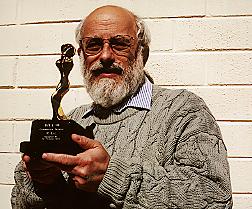Growing Older in a Youth Focussed Culture
By: Richard Buckdale (Sep 19 2022)Growing Older as a Gay-Lesbian-Bi-Trany-Queer
in a Youth Focussed Culture
 Regrettably, today in Australia, “Growing Older as a Queer in a Youth Focussed Culture” is largely a story of ageism and mature age phobia.
Regrettably, today in Australia, “Growing Older as a Queer in a Youth Focussed Culture” is largely a story of ageism and mature age phobia.
To understand ageism properly, I feel it is essential to see it as an important component of a wider phenomenon: lack of full acceptance of diversity. Tolerance of diversity also is not an adequate goal. We need to build a society in which diversity is both nurtured and treasured. This applies to both the queer community and the Australian community as a whole, and should include respect for:
All religions including Islam, Judaism, Hiduism & Buddhism and also respect for atheism, the philosophy that there is no god
- All sexually related choices & relationships, providing they do not hurt others, including same-sex relationships, bisexual relationships, tranys, monogamy & polygamy
- The right to equal opportunity irrespective of sex and to a non-sexist milieu in which women are not treated as second-class citizens
- All races & ethnic groupings and their traditional customs. In this context, one focus for Australia should be on indigenous rights, needs & social relationships such as land rights, native title & reconciliation
- The rights of workers and the right to freedom from fascist-style terrorism as for example, perpetrated against the MUA and the waterside workers
- The environment, including our animal origins as a sibling of the pigmy chimpanzee (or bonobo), and respect for philosophies that originate from this such as nudism and ecology
- The rights and needs of disabled members of our community. I was horrified to discover that Fortress Erskineville, the Sydney Gay and Lesbian Mardi Gras centre, still does not supply adequate access for people in wheelchairs
- The rights and needs of Australian citizens of all ages.
Mature age queers have to survive in two youth focussed cultures-the queer culture, and the youth culture of the entire Australian population. I’d like to concentrate tonight on the queer culture. Parenthetically, I’d like to add here that teenagers in our queer culture have also been neglected in the past by some of our organisations who tend to focus on the middle-aged.
Let’s then have a look at some of the problems faced by mature age gays.
Gay venues focus on youth. There are frequently inadequate, if any, chill-out spaces. The environment is typically highly-noisy or rather deafening, often with little room to move and little space to sit down
Public parties such as Sleaze & Mardi Gras are almost subservient to the youth drug culture with pot & ecstasy abounding. Many mature age queers would at least like areas which are drug free
At many sex-on-premises venues, ageism is very apparent. At Bodyline, for example, young guys almost always look for other guys close to their own age. They miss out on having a different type of relationship with, perhaps, a different quality, between themselves and maturer, more experienced guys. Equally, they tend to deprive the more mature guys from having a relationship with them, if only a one-night-stand or indeed a twenty-minute-stand. Symptomatic of the psychosexual thinking in this regard is the common phrase “dirty old man”, often said with considerable venom. The implication here is that people over the age of fifty ought to be celibate. But, of course, we’re not. Indeed, from discussions held at MAG, it is quite clear that most of our mature age gay members do not lose sexual desire whatever their age.
There is an emphasis on outward appearance rather than inner beauty within the queer community and also in the Australian community as a whole. Basically this means that beauty is largely equated with youth, and the wisdom of maturity, such as it is, is often ridiculed or feared. This attitude has persisted for a long time. It is no accident that “witches” who were hunted and burnt at the stake in the 17th & 18th centuries in Europe and America, were in general mature women and almost never young adults.
Mature people tend to be seen as frail, weak, “with one foot in the grave” and “past it” in a dog-eat-dog society that rewards the strong and the super-competitive “stars”. This can not only result in mature people becoming invisible. With regard to mature age queers, there is real and justified fear-fear not only of loud-mouthed verbal abuse, but also of physical abuse leading to injuries or death. Young straights, or young gays trying to prove themselves to their homophobic friends, attack mature age lesbians & gays because, being older, they are perceived as being weaker and less able to counter attack. The organisation of which I’m President, Mature Age Gays, has the largest regular attendance of any queer organisation in Australia-typically over 100 guys at each of our two meetings a month on the second and last Saturdays of every month. We have the largest regular attendance because we offer a safe haven where mature age gays find acceptance. Here our members don’t have to justify their existence to the youth culture and are free from verbal abuse, physical attacks & intolerance by younger members not only of the straight community but also of the queer community.
Given these and other problems, is there any hope for us oldies? Is it ingrained in “human nature” to ignore, ridicule, attack and abuse the older members of society or is this a result of societal conditioning? Clearly it is the latter, as other human societies such as Australian indigenous societies traditionally show not only tolerance for, but indeed great respect for, their more mature members. The views of the “elders” in Australian Aboriginal culture are always of paramount importance. What can we do then, to reduce ageism both in the queer community and the Australian community as a whole?
Here are some suggestions:
- Queer organisations should sponsor seminars & discussion groups, such as this tonight, where these injustices can be aired and where queers of different ages can mix and influence each other;
- We should consciously aim to have the mature viewpoint, or mature viewpoints, well-represented on strategic committees and organisations of our queer community. When the current Mardi Gras board contacted organisations for feedback for their Strategic Plan, MAG was not on this list despite being the largest gay organisation in Australia with regular meetings. The current Mardi Gras Board has no member over fifty. We need to have people on committees whose specific focus is to represent the mature queer community;
- Queer media should assist this process by providing columns for mature representatives of the queer community, and having articles, discussing those issues critical to the mature age queer community;
- Posters and literature in the form of pamphlets and videos should make queers conscious of ageism. These should aim to get over the message that ageism and age-phobia are negative philosophies that prevent the younger community from reaping the benefits of the wisdom, experience & love of the more mature;peaking to one’s friends helps. Word-of-mouth struggles against ageism and for tolerance, respect & consideration can make a substantial contribution to the elimination of discrimination against the mature. Basically, we should make ageism a mass question within the queer & straight communities just as sexism was made a mass question by feminists and their supporters;
- We should create some institutions which serve the mature queer community, such as queer retirement villages. There is some interesting information from the United States on this which would undoubtedly be mirrored in Australia. A J Lucco in “Planned housing preferences of older homosexuals” Journal of Homosexuality 14 (3/4) pp 35-36, 1987, found that almost 88% of homosexuals polled wanted housing that was sensitive to gay and lesbian ageing issues. The importance of this is evidenced from the estimates of the mature queer population given by Linda M Woolf PhD from Webster University, in her May 1998 paper “Gay and Lesbian Ageing”. In this, she gives a range of estimates from 1.75 to 3.5 million for older gay men & lesbians in the United States. She further points out that “to put these figures in perspective, this is approximately equal to or two times greater than the number of older adults living in a nursing home setting”. Clearly, queer retirement villages will become important for mature queer communities in the United States and, even more, we should be doing something in this direction in Australia.
There is one important point in the favour of maturing queers, as distinct from their straight brethren, in the fight for justice & human rights in a youth focussed culture: Many mature gays & lesbians have experienced the stigma of homosexuality and fought against it. We are therefore in a good position, as we mature and hopefully also in our youth, to take up the cudgels once again to fight against the stigma of growing old. Let’s all involve ourselves in this struggle and also, to return to my original theme, in the struggle for tolerance, love and nurturing of all manifestations of diversity in our society!



